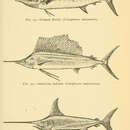Diagnostic Description
provided by Fishbase
Body elongated and compressed; upper jaw produced into a robust and medium sized beak; two dorsal fins, the height of the first greater than the greatest depth, short anteriorly, taller in the middle, then becoming shorter posteriorly; pectoral fins falcate and flexible, with 18 to 22 rays; body densely covered by small, embedded scales with 1 or 2 bluntish points; back dark blue; belly silvery; membrane of first dorsal fin blue black without dark spots; flanks with about 20 bluish stripes (Ref. 55763). Blue-black above and silvery white below, with about 15 rows of cobalt-colored stripes; 1st dorsal fin dark blue; other fins dark brown, sometimes with a tinge of dark blue; anal fin bases with a tinge of silvery white.
- Recorder
- Cristina V. Garilao
Life Cycle
provided by Fishbase
Females are indeterminate batch spawners with asynchronous oocyte development (Ref. 92477). Larvae are most abundant in the respective local early summers. The seasonal occurrence of mature females coincides with that of the larvae. The lower temperature limit in the distribution of larvae is approximately 24°C, both in the Indian and Pacific Oceans.Spawning sites are between 10°S and 30°S in Southwest Pacific and 10°S and 20°S in northeastern Indian Ocean (Ref. 6390).
Migration
provided by Fishbase
Oceanodromous. Migrating within oceans typically between spawning and different feeding areas, as tunas do. Migrations should be cyclical and predictable and cover more than 100 km.
Morphology
provided by Fishbase
Dorsal spines (total): 0; Dorsal soft rays (total): 42 - 48; Analspines: 0; Analsoft rays: 18 - 24
- Recorder
- Cristina V. Garilao
Trophic Strategy
provided by Fishbase
There is little information on the distribution of striped marlin eggs and larvae (Ref. 6390). Juveniles are relatively rare in the southwest Pacific Ocean (Ref. 30443). Fish of 4-10 kg (80-100 cm FL) are regularly caught on longlines in the region but concentrations of fish this size are most restricted to the northcentral Pacific Ocean (Ref. 30443).Striped marlin are carnivorous, non-selective feeders whose diet includes more epipelagic organisms than the diets or other billfish and larger tunas (Ref. 6390). Their diet changes with season and locality (Ref. 6390).
Biology
provided by Fishbase
Epipelagic and oceanic species, usually found above the thermocline. Generally inhabit cooler water than either black (Makaira indica) or blue marlin (M. mazara) (Ref. 43). Most dominant and widely distributed of all billfishes. Their abundance increases with distance from the continental shelf (Ref. 6390). Usually seen close to shore only where deep drop-offs occur (Ref. 6390). Mostly solitary, but form small schools by size during the spawning season (Ref. 9987). They are usually dispersed at considerably wide distances. Feed on fishes, crustaceans and squids. Also caught with the harpoon. The flesh is the best among billfishes for sashimi and sushi. Marketed mostly frozen, sometimes fresh (Ref. 43); also smoked and frozen (Ref. 9987). Also Ref. 9137, 9574.
Importance
provided by Fishbase
fisheries: commercial; gamefish: yes

